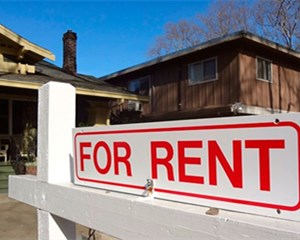Over the long run, however, economic theory suggests that rents and prices should move in tandem (ie, the ratio of house prices to rents should be stable). If rental growth catches up with prices, that could have a big effect. Rents make up one-fifth of the basket used to calculate "core" personal-consumption-expenditure (PCE) inflation, which excludes food and energy—the gauge most closely watched by the Fed. If annual rent inflation rose to 4% a year—not far off where it was shortly before the pandemic—overall core inflation would rise by 0.5 percentage points.
然而,從長期來看,經(jīng)濟理論表明租金和房價應該同步變動(也就是說,房價和租金之間的比率應該是穩(wěn)定的)。如果租金增長趕上了房價,那么可能會產(chǎn)生很大的影響。租金在用于計算“核心”個人消費支出(PCE)通脹(不包括食品和能源——美聯(lián)儲最密切關注的指標)的籃子中占了五分之一。如果租金的年通脹率上升到每年4%——和新冠大流行前不久差不多——整體核心通脹率將上升0.5個百分點。
Could this happen as the economy recovers, landlords may hope to make up for lost time. "We expect a rental-market resurgence in 2021," said Zillow, a property firm, in a report in December, "with rents increasing...and demand for rental housing strengthening." A recovery in low-wage employment should boost rents: housing-cost inflation tends to rise when the unemployment rate falls. A survey by the New York Fed in April found that households expected rents to rise by 10% in the coming year, up from expectations of 5%, on average, in 2020.
這會發(fā)生嗎?隨著經(jīng)濟的復蘇,房東們可能希望彌補失去的時間。房地產(chǎn)咨詢公司Zillow在去年12月的一份報告中表示:“我們預計2021年租賃市場將會復蘇,隨著租金上漲……租房需求也會加強。”低薪就業(yè)的復蘇應該會提振房租:當失業(yè)率下降時,住房成本通脹往往會上升。紐約聯(lián)邦儲備銀行4月份的一項調(diào)查發(fā)現(xiàn),美國家庭預計未來一年房租將上漲10%,高于2020年平均5%的預期。

Rental inflation is thus likely to rise in the coming months. But by how much is another question. There are reasons to think the price-to-rent ratio could settle at a permanently higher level. When interest rates are so low, for instance, people are willing to pay more for the right to a given stream of income. American price-to-rent ratios are higher today than in the 1980s, which coincides with declines in real interest rates.
因此未來幾個月租金上漲可能會加劇,而上漲多少就是另外一個問題了。購租比可能會永久性保持在較高水平,這么說是有理由的。例如,當利率極低時,人們愿意花更多的錢來獲得特定的收入流。如今美國的購租比比上世紀80年代要高,而當時的實際利率正好在下降。
A slower pace of housing construction may also keep price-to-rent ratios higher, suggests a new paper by Christian Hilber of the London School of Economics and Andreas Mense of the University of Erlangen-Nuremberg. In thriving areas where the supply of housing is constrained, buyers may be willing to bid up prices in the expectation of strong rental growth in the future. In recent years America has become worse at building new houses, in part because of tougher land-use regulations.
住房建設步伐的放緩也可能會使房價與租金比率保持在較高水平,倫敦經(jīng)濟學院的克里斯蒂安·希爾伯特和埃爾蘭根-紐倫堡大學的安德里亞斯·門斯在一篇新論文中指出。在住房供應有限的繁華地區(qū),購房者可能愿意哄抬房價,因為他們預計未來的租金將強勁增長。近年來美國在建造新房方面的能力越來越差,部分原因是受限于更嚴格的土地使用規(guī)定。
American price-to-rent ratios could of course adjust in another way—through prices falling, rather than rents rising. Just as share prices are more volatile than dividends, house prices are more up-and-down than rents. And Mr Detmeister's historical analysis suggests that two-thirds of any adjustment in price-to-rent ratios tends to fall on prices. In other words, America might be able to have either a strong housing market or quiescent inflation—but not both.
美國的購租比當然可以通過另一種方式進行調(diào)整——通過降低房價,而不是調(diào)高租金。就像股價比股息更不穩(wěn)定一樣,房價也比租金更起伏不定。德梅斯特的歷史分析表明,在任何購租比的調(diào)整中,三分之二會趨向于降低房價。換句話說,美國可能要么擁有強勁的房地產(chǎn)市場,要么擁有平靜的通脹——但二者不能兼得。
譯文由可可原創(chuàng),僅供學習交流使用,未經(jīng)許可請勿轉載。











